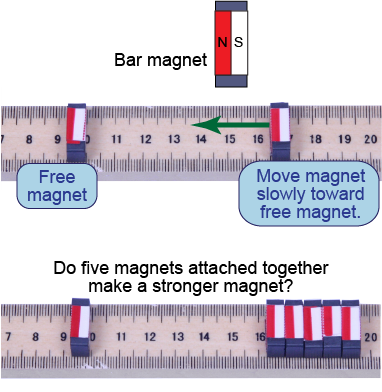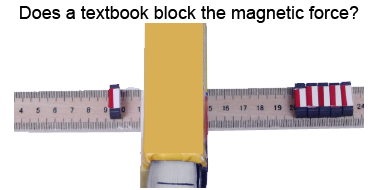|
| Essential questions | | At what distance does the magnetic force operate?
Can magnets be combined to make a stronger magnet? | |
|
The magnetic force between two magnets will act to repel or attract them to each other, depending on the relative orientation of their magnetic poles. In this investigation, you will characterize the magnetic force between bar magnets. You will observe how the magnetic force varies with separation between magnets, whether combining magnets creates a more powerful magnet, and to what extent the magnetic force is affected by an intervening material. 
|
Part 1: Magnetic force between bar magnets

- Place a free magnet and a test magnet on a ruler on the table.
- Slowly move the test magnet closer to the free magnet until the free magnet begins to move. Measure the distance at which the free magnet begins its movement.
- Repeat for different combinations of poles: north–north; south–south; and north–south.
- Create a composite bar magnet by connecting five small magnets together. Use it as a test magnet and record the distance at which the free magnet begins its movement.
- What is the distance over which the magnetic force between these magnets acts?
- Does the combination of five magnets create a stronger magnetic force?
- Why does the free magnet only start to move suddenly? (Hint: Does the free magnet have to overcome a different force?)
- In which configuration was more energy available, the individual bar magnet or the five magnet combination? Why?

|
Part 2: What blocks a magnetic force?

- Hold a textbook in place between the magnets. Measure the distance at which the free magnet begins to move.
- Repeat for various materials: glass, a block of wood, a block of metal, and a pile of nails.
- Do any of these materials block the magnetic force between bar magnets? Justify your answer.

|

